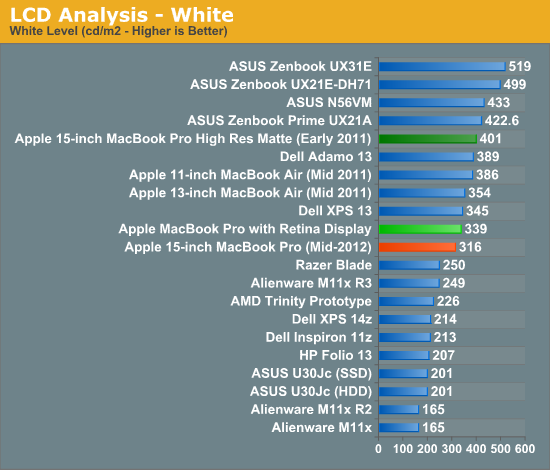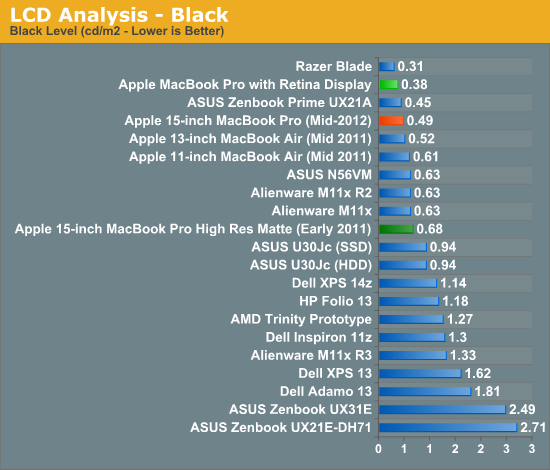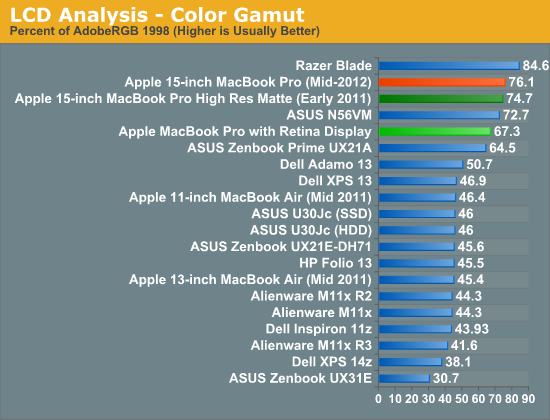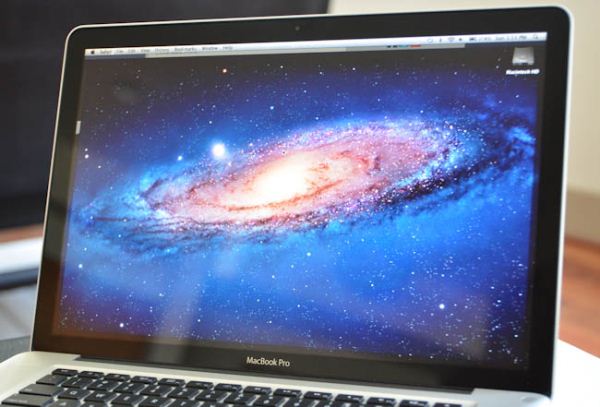The 2012 MacBook Pro Review
by Vivek Gowri on July 18, 2012 2:00 PM EST- Posted in
- Mac
- Apple
- MacBook Pro
- Laptops
- Notebooks
The story about the regular MacBook Pro's display is more about what it isn't (game changing) because we already know what it is (very competent). As always, the display is a very high quality one, essentially the same as the previous 3 years of MacBook Pros and testing very similarly to the other 15" MacBook Pros we've reviewed over the last few years. Our evaluation unit had the base 1440x900 display, though I'd have preferred the matte WSXGA+ panel. The higher resolution is nice to have, and with the matte screen finish, it was one of my absolute favourite notebook displays.




In terms of display performance, the 2012 MBP matches up very close to the 2011 and 2010 models, with very good contrast ratio and colour reproduction. But that’s the thing with the regular 2012 MBP – it’s just like the 2011 and 2010 MBPs, just updated to IVB/Kepler.
The real story here is about what you’re giving up. After using an rMBP, it's actually a little bit difficult to go back to a normal MBP display. I mean, this is by far the biggest differentiating factor between the two, and if you’re looking for a solid reason to put the money down for a Retina, this is it. The normal MBP has a good display, a very good display if you go for the matte high-res option, but the Retina MBP display is just on a completely different level. Like the new iPad, the resolution difference doesn’t add to the screen real estate so much as allowing for a vastly improved UX with higher resolution UI elements and better text rendering. It’s difficult to quantify, and it’s easy to dismiss on the surface, but when you actually use a super high-res panel for a prolonged amount of time, you understand the difference it makes. Obviously, there are still some bugs, and it’ll take probably one full development cycle for most applications to be updated to Retina-spec textures and UI elements, but that is all to be expected in a radical shift such as this. If you’re comfortable sticking to the tried-and-true MBP display, it’s not a bad way to go, but I’d advise you to use a Retina MBP before making a decision to go one way or the other.











132 Comments
View All Comments
snajk138 - Saturday, July 21, 2012 - link
The GPU only matters for games though, and neither machine is really ment for that.Less storage depends on how you order it, the thinkpad can have an SSD in the m-SATA port, an SSD or HDD in the HDD-bay and an optical unit, SSD or HDD in the optical bay. So, more options.
The trackpad is better on a mac but it doesn't offer a trackpoint (nub, nipple, clit or whatever you want to call it) that many prefer to any trackpad and Thinkpads have arguably the best keyboards of any laptops. Magsafe is mostly a gimmick, a solution to a problem that doesn't exist. OSX isn't more optimized for laptops than Windows.
cyabud - Thursday, July 19, 2012 - link
It is a shame that Apple hardware is so expensive and it's the primary reason that thousands of geeks out there are experimenting with hackintoshes.I run Windows and OS X on my machines (Windows for games, OS X for everything else) partly because I prefer OS X and partly because I use software (namely Logic and Final Cut) that only exist for OS X.
I've been through my fair share of MBPs over the years but in 2009 I decided to build a desktop and go the hackintosh route. It is virtually identical to an Early 2009 Mac Pro (single CPU model) and I saved about €1000 in the process.
When it comes to notebooks though, I will still cough up the extra cash for a Macbook because I know it'll run both OS X and Windows without a hitch. Getting OS X running on a PC is considerably harder when you don't get to pick and choose each individual component in the system.
Although there are things I admire about Apple (tight integration between product lines, pushing high res displays into the consumer market and a lot of the very high quality software that comes bundled with Macs) it is a real shame that ultimately choice of hardware is so limited and you're pretty much obliged to pay a premium for it if you want OS X (and you're not a geek who's willing to get his hands dirty).
If OS X isn't your cup of tea or vital to your workflow, there are very few reasons to justify buying a Mac.
ABR - Thursday, July 19, 2012 - link
When will we stop getting these tired old posts comparing specs? Yes, you can buy a Chevy Impala with the same horsepower, gas mileage, etc. as a BMW 3 Series. It'll probably last decently and be easier/cheaper for you to fix if something goes wrong. Does that mean you're willing to pay the same price as for the BMW? Folks, the whole is not the sum of the parts.Even if you somehow conclude that Windows with all of its need to manage anti-virus and anti-spyware spyware, hunt down media management/creation programs OS X gives you out of the box, deal with DOS legacy clunk, etc. is on parity with OS X, you are still missing the little things and the intangibles that bring the whole experience up to a different level. I could list these and you could laugh at them, just as you can laugh at BMW owners for wasting their money when half their cash would have gotten them equally well from point A to point B. But that's not going to stop people from buying them. A "lifestyle choice"? Heck yes!
cyabud - Thursday, July 19, 2012 - link
Although I understand and agree with much of what you're saying about the intangibles of OS X; you're still assuming that OS X is "better" than Windows. Arguing over which system is better is pointless as it's completely subjective.In my opinion Windows is better for games and broad software compatibility. There are also some great features in Win 7 like window snapping which require the purchase of a cheap app if you want the same functionality in OS X.
On the other hand, I find I work more efficiently in OS X and everything feels more fluid and fast. I run both systems off solid state storage, while all my media resides on hard drives, and I still find that OS X boots/sleeps/shuts down faster and generally feels more responsive overall.
Have you ever tried sitting someone in front of a Mac who's never used on before? I think you'll find that most will tell you it's not as intuitive as fanboys like to make out and that Windows is "much easier to use". Ultimately it's all down to what you're used to and your personal preferences/needs when it comes to the software you use.
If you run both systems you truly get the best of both worlds.
ABR - Thursday, July 19, 2012 - link
I didn't mean just OS X, I meant the hardware also. Things like the feel of the machine, the way it clicks when you close it, the soft, analog pulsing of the sleep light, the battery indicator, the lack of cheesy Intel stickers, etc. etc.. The details of the experience are paid attention to by the engineers and designers, and it makes a difference to the QUALITY of the experience perceived by (some, not all) users.I agree with you about one OS or the other seeming "easier to use" based on experience, and in fact would even say 7 has brought Windows pretty close to the Mac in terms of a lot of this "quality" stuff from just the OS perspective. But it's the whole experience that matters, not just software or hardware alone.
uiane - Wednesday, July 18, 2012 - link
Man, the retina is a beauty!!the main issue is, FIREWIRE.
We audio people are left with no option other than de 15" cheaper version + SSD + 16GB.
and maybe swap the drive for a second HDD. (lossing the warranty)...
Everytime I think in trading my Late 2011 15" I think on the retina with 512GB SSD and 16GB ram on, but then, NO FIREWIRE.
Apple talked about a thunderbolt to firewire adapter in july... well, july is passing.
inplainview - Thursday, July 19, 2012 - link
On August 1st you have a valid gripe... Until then, not so much...Prism - Wednesday, July 18, 2012 - link
In regards to the pricing comparison in this article:When I bring the base 15" MBP up to rMBP standards with an additional 4gigs of RAM and swap out the HDD for the 256gig SSD, it ends up being $200 MORE than the rMBP, not $100 less. Just wanted to point that out...
Death666Angel - Friday, July 20, 2012 - link
Let's see:We have the base MBP for
$1799
then he adds a Samsung 830 256GB and 4GB RAM which he says cost
~$250 + ~~$50 => ~$300
making the total
$1799 + $300 = $2099
Which is $100 less than the rMBP starting point of $2199.
Then he say that if you are eligible for student discounts, the rMBP is priced not $100 higher but actually the same, since it is discounted more heavily.
Maybe you are going by Apple upgrade prices?
Roland00Address - Wednesday, July 18, 2012 - link
Why did they went with the i7 dual core (3520m) with the 13 inch instead of the i7 quad core (3612qm). The tray price of the i7 dual core is $346, the i7 quad is $378 so that is a $32 dollar difference. Both chips are 35 watt tdp (this is a first for intel, some ivybridge i7 quad cores has a 35w tdp while sandybridge did not have such a chip in a laptop.) Only other possible reason besides $32 dollar cost is the dual core supports intel vt-di7 3612qm
2.1 ghz base speed
2.8 ghz quad core max turbo
2.8 ghz tri core max turbo
3.0 ghz dual core max turbo
3.1 ghz single core max turbo
i7 3520m
2.9 ghz base speed
3.4 ghz dual core max turbo
3.6 ghz single core max turbo